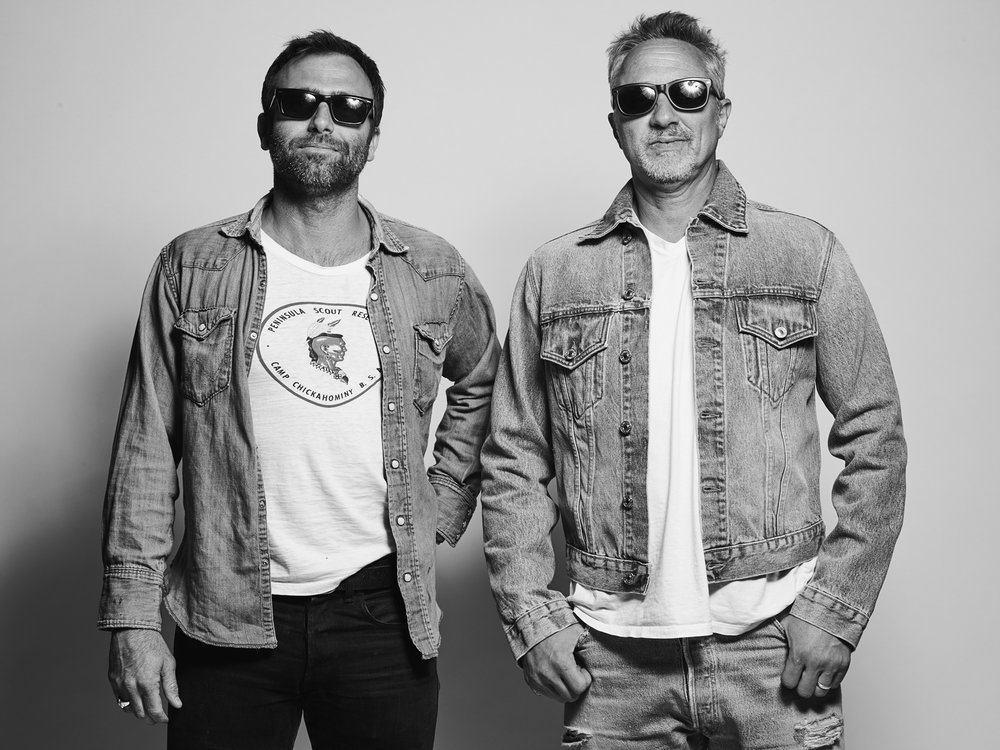How they started, why they love vintage denim, and why ‘upcycling’ is so important in today’s market.

Sean Barron and Jamie Mazur
words by LUCY BULLING • Fashion
“Upcycling is taking pre-loved garments and extending their lives by reconstructing them into something new…We want to disrupt the pattern of throwing away quality clothing”.
The beloved denim jean is as much a wardrobe staple as it is a part of our lives. The simplicity, durability, and versatility of the classic blue hue has seen the jean evolve from a men’s workwear staple to an every-day must-have, donned by the likes of models, celebrity, and every high-street wanderer in between.
Form, fit, and function are imperative characteristics of the perfect pair and re-worked vintage denim label, RE/DONE, continue to procure the essential balance between all three. Working closely with denim juggernaut, Levi’s®, Sean Barron and Jamie Mazur have developed their ‘upcycling’ ethos and established one of the best luxury denim labels on the market.
Julia von Boehm: Explain your ethos of ‘upcycling’
Sean Barron: To me, upcycling is taking pre-loved garments and extending their lives by reconstructing them into something new. Fashion creates a ton of waste. We want to disrupt the pattern of throwing away quality clothing just because it’s not currently on trend by utilizing these discarded pieces to make something timeless and exciting. Upcycling is a key aspect of circular fashion, which must be the future of the industry if we want our Earth to remain habitable.
Jamie Mazur: In many cases, the fabric quality and construction of vintage garments is far better than what’s usually produced today. Upcycling is a win-win for us; we are able to take advantage of the quality and character of vintage without creating waste.
JVB: How did both of you get into fashion?
JM: Growing up in Los Angeles, many of my friends’ dads worked in denim. In their presence, I became obsessed with denim and all things vintage. I love all kinds of design, so fashion was the most encompassing of all of my interests.
JVB: You collaborate with a number of brands, models, and influencers – how do you decide who you partner up with?
SB: The most important thing when deciding who to partner with is that their brand and ours share core aspects of identity. We love working with people who share a mutual interest in sustainability and vintage. Most of our collaborations have come about organically. For example, I met Giorgia and Gilda of The Attico at a party we threw in Paris and got to talking about how vintage inspires both of our design processes. I took them to some rag houses in Los Angeles when they were in town, and then we decided we wanted to collaborate in reconstructing some of the pieces we found.
JM: I love to collaborate with American heritage brands that are iconic, but not necessarily in the luxury space. I primarily wear vintage so I’m constantly thinking about the brands that have owned their spaces throughout history and still remain relevant and desirable.
SB: Unlike most other luxury brands, we were born online. Social media has been huge for us, but it has been super organic. Our business informs our social media, not the other way around.
JVB: You’re famous for re-cutting vintage denim into new patterns, how do you determine the ‘perfect’ fit (especially when you’re repurposing old menswear and turning it into womenswear)
SB: When repurposing vintage men’s jeans for women, the fit is the most important thing for us to think about. Our vision usually begins with a denim style iconic to a specific decade. We think about the details from our inspiration that lend themselves to that specific time frame, and figure out how to recreate them within the constraints of our raw goods. From there, we tailor the fit to ensure that the jean is actually flattering. No matter how cool we think a jean is, it has to be flattering and make sense within the modern context.
JVB: What is your relationship like with the Levi’s brand/company? How do they view what you are doing with their vintage pieces?
SB: Our relationship with Levi’s is great and mutually beneficial! We are the only brand that is officially partnered with them. They love what we do, as we’ve helped reintroduce their brand to the luxury customer while honoring their rich heritage and status within American fashion.
JVB: What is the most exciting/challenging part about working in the ‘vintage’ realm, as opposed to making new jeans from scratch?
SB: There’s nothing like vintage denim. Personally, contributing to the circular fashion movement is the most rewarding and exciting part of our reconstructed Levi’s business. It completely outweighs the challenges of working with a more diverse raw material.
JM: Each jean is 100% one-of-a-kind and a small piece of history. Vintage jeans have a ton of character with unique fading, destruction, and wear patterns — that individuality can also be a challenge as each jean will fit a bit differently, but it is completely worth it.
JVB: What’s the hottest denim trend right now?
SB: Long and loose!
JM: Denim that doesn’t look trendy.
JVB: What’s next for Re/Done?
SB: We have some very exciting projects coming up. Look out for sustainable tees and “new” jeans constructed from deadstock denim. We’ll also be launching shoes!
JM: We will be launching our first men’s collection very shortly!



